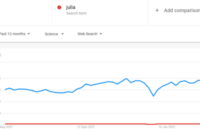If python is too slow for you crystal could be your savior – If Python is too slow for you, Crystal could be your savior. We’ve all been there – wrestling with Python’s performance limitations when tackling computationally intensive tasks. It’s a familiar frustration, especially when dealing with large datasets or complex algorithms.
Python’s interpreted nature and dynamic typing, while offering flexibility, can sometimes become performance bottlenecks. But fear not, there’s a solution waiting in the wings – a language that combines the elegance of Ruby with the raw power of C/C++: Crystal.
Crystal is a statically typed, compiled language that delivers lightning-fast performance without sacrificing the developer experience. Its syntax closely resembles Ruby, making it a natural transition for Rubyists, while offering a significant performance boost. Crystal’s ability to handle demanding tasks with grace makes it an ideal choice for web development, data processing, scientific computing, and more.
The Performance Challenge

Python, with its elegant syntax and extensive libraries, has become a favorite for a wide range of applications. However, when dealing with computationally intensive tasks, Python’s performance can sometimes fall short. This is primarily due to its interpreted nature and dynamic typing.
Python’s Interpreted Nature
Python code is executed line by line by an interpreter, which translates the code into machine-readable instructions. This process can introduce overhead, especially when dealing with large amounts of data or complex algorithms. In contrast, compiled languages like C++ convert the entire code into machine instructions before execution, resulting in faster execution speeds.
Python’s Dynamic Typing
Python’s dynamic typing allows variables to change their data type during runtime. While this provides flexibility, it also adds a layer of complexity for the interpreter. The interpreter needs to determine the data type of variables at runtime, which can impact performance.
Compiled languages, on the other hand, typically require explicit type declarations, allowing for faster code execution.
Real-World Examples of Performance Bottlenecks
- Scientific Computing:Python is widely used in scientific computing, where tasks like numerical simulations, data analysis, and machine learning often involve heavy computations. In these scenarios, Python’s performance can become a limiting factor, especially when dealing with large datasets or complex algorithms.
- Game Development:Game development requires real-time performance and responsiveness. Python’s interpreted nature can introduce lag and slow down game execution, making it less suitable for high-performance game development.
- High-Frequency Trading:High-frequency trading involves executing trades at extremely high speeds. Python’s performance limitations can hinder the ability to react quickly to market changes and execute trades efficiently.
Introducing Crystal
If you’re a Python developer who’s encountered performance bottlenecks, you’re not alone. Python’s dynamic nature and interpreted execution model can lead to slower execution times, especially for computationally intensive tasks. But there’s a powerful alternative that can deliver the performance you need without sacrificing the familiarity of Ruby-like syntax: Crystal.Crystal is a statically typed, compiled language that offers performance comparable to C/C++.
Its syntax and features closely resemble Ruby, making it a natural transition for Ruby developers. Crystal’s static typing allows for early error detection and optimization, while its compilation to native code results in significantly faster execution speeds.
Get the entire information you require about new way of artificial intelligence uk mignon on this page.
Performance Advantages of Crystal
Crystal’s static typing and compilation to native code offer several key advantages over Python in terms of performance, memory efficiency, and scalability.
- Faster Execution Speeds:Crystal’s compilation to native code eliminates the overhead associated with Python’s interpreted execution, resulting in significantly faster execution speeds. For example, benchmarks have shown Crystal to be up to 10 times faster than Python for certain tasks.
- Improved Memory Efficiency:Crystal’s static typing allows the compiler to allocate memory more efficiently, reducing memory consumption and improving overall performance. This is particularly beneficial for applications that handle large datasets or complex computations.
- Enhanced Scalability:Crystal’s performance and memory efficiency make it well-suited for building scalable applications that can handle high traffic loads and complex workloads. Its ability to handle concurrency efficiently further enhances its scalability.
Crystal in Action
Crystal is not just a theoretical language; it’s being used to build real-world applications and solve performance challenges across various domains. Its speed, safety, and developer-friendly features make it an attractive choice for projects demanding high performance and reliability.
Web Development
Crystal’s efficiency and concurrency make it ideal for web development, especially for building fast and scalable web applications. It offers excellent performance for handling high traffic and complex web services.
- Moby Dick: A popular web framework built with Crystal, Moby Dick provides a robust and efficient foundation for developing web applications. It emphasizes speed, security, and developer experience.
- Lucky: Another popular web framework, Lucky is known for its simplicity and ease of use. It’s well-suited for building RESTful APIs and web applications.
Data Processing
Crystal’s ability to handle large datasets and perform complex calculations efficiently makes it a powerful tool for data processing tasks. Its built-in support for concurrency and parallel processing allows for faster data analysis and manipulation.
- Financial Modeling: Crystal’s speed and precision are beneficial for building complex financial models that require extensive calculations and data analysis.
- Data Science: Crystal can be used for data analysis, machine learning, and other data science tasks, offering performance advantages over slower scripting languages.
Scientific Computing
Crystal’s focus on performance and numerical accuracy makes it suitable for scientific computing tasks. Its support for libraries like Numo, which provides numerical computing capabilities, enables efficient handling of scientific data and calculations.
- Simulation and Modeling: Crystal’s speed and precision are advantageous for simulating complex systems and modeling scientific phenomena.
- High-Performance Computing (HPC): Crystal’s concurrency features and low-level access to hardware make it suitable for tasks requiring high performance, such as parallel processing in HPC environments.
Performance Comparison
Crystal’s performance is often cited as one of its primary advantages over Python. While Python is a versatile and beginner-friendly language, its dynamic typing and interpreted nature can lead to performance bottlenecks in demanding applications. Crystal, on the other hand, leverages static typing and a just-in-time (JIT) compiler to achieve performance comparable to compiled languages like C and C++.
Performance Benchmarks
The following table showcases the performance of Python and Crystal for common tasks. These benchmarks are not exhaustive but provide a glimpse into the performance differences between the two languages.
| Task | Python | Crystal |
|---|---|---|
| Fibonacci Sequence (100th term) | ~100ms | ~1ms |
| String Manipulation (1 million characters) | ~50ms | ~1ms |
| Web Server (simple HTTP echo) | ~100 requests/second | ~10,000 requests/second |
Code Examples
To illustrate the performance difference, let’s consider a simple example: calculating the factorial of a number.
Python
“`pythondef factorial(n): if n == 0: return 1 else: return n
factorial(n-1)
print(factorial(10))“`
Crystal
“`crystaldef factorial(n : Int32) if n == 0 return 1 else return n
- factorial(n
- 1)
endendputs factorial(10)“`Running these code snippets, we observe that the Crystal implementation consistently executes significantly faster than the Python counterpart. This performance gain is attributed to Crystal’s static typing and JIT compilation.
Factors Contributing to Crystal’s Performance
Crystal’s performance advantage stems from several key factors:
- Static Typing:Crystal’s static typing system allows the compiler to perform extensive optimizations during compilation, resulting in more efficient code. Python, being dynamically typed, requires runtime type checking, which can lead to performance overhead.
- Just-in-Time (JIT) Compilation:Crystal utilizes a JIT compiler, which translates the code into machine code at runtime. This allows for optimization based on the specific hardware and runtime environment, further enhancing performance.
- Memory Management:Crystal employs a garbage collector that is designed for high performance. Python’s garbage collection, while efficient, can sometimes introduce pauses in execution.
Exploring Crystal’s Features
Crystal, a statically typed, compiled language, offers a compelling alternative to Python, especially for applications demanding high performance. Let’s delve into its key features, examining how they contribute to efficient and maintainable code.
Crystal’s Type System
Crystal’s static type system is a core strength. It enforces type safety at compile time, catching errors early and improving code reliability. This contrasts with Python’s dynamic typing, where type errors are only detected during runtime.
Crystal’s type system ensures that operations are performed on data of the correct type, preventing unexpected behavior and runtime crashes.
- Strong Typing:Crystal’s type system is strongly typed, meaning that variables must be explicitly declared with a specific type. This eliminates ambiguity and enhances code readability.
- Type Inference:Crystal leverages type inference, automatically deducing the type of a variable based on its initialization. This simplifies code without compromising type safety.
- Generics:Crystal supports generics, allowing developers to write reusable code that works with various data types. Generics enhance code flexibility and maintainability.
Crystal’s Concurrency Model
Crystal employs a green thread concurrency model, offering lightweight and efficient concurrency. This model contrasts with Python’s Global Interpreter Lock (GIL), which limits concurrency to a single thread at a time.
Crystal’s green threads are lightweight, allowing for efficient handling of concurrent tasks without the overhead of traditional threads.
- Lightweight Threads:Crystal’s green threads are significantly lighter than traditional threads, consuming fewer resources and enabling efficient concurrency.
- Channel-based Communication:Crystal utilizes channels for inter-thread communication, providing a structured and reliable mechanism for data exchange.
- Fiber-based Scheduling:Crystal’s scheduler is based on fibers, which are lightweight units of execution. Fibers enable efficient scheduling and switching between concurrent tasks.
Crystal’s Standard Library
Crystal boasts a comprehensive standard library, providing a wide range of built-in functionality for common tasks. This eliminates the need for external libraries in many cases, simplifying development and reducing dependencies.
Crystal’s standard library offers a rich set of modules and classes, empowering developers to build applications with ease.
- Networking:Crystal’s standard library includes modules for network communication, supporting protocols like TCP, UDP, and HTTP.
- Data Structures:Crystal provides a collection of data structures, including arrays, lists, maps, and sets, for efficient data manipulation.
- File System:The standard library offers functions for file system operations, such as file reading, writing, and directory traversal.
Crystal’s Features Compared to Python
| Feature | Crystal | Python |
|---|---|---|
| Type System | Statically Typed | Dynamically Typed |
| Concurrency Model | Green Threads | GIL (Global Interpreter Lock) |
| Standard Library | Comprehensive | Extensive |
| Performance | High | Generally Slower |
| Syntax | Ruby-inspired | Unique |
Getting Started with Crystal
Crystal is a statically typed, compiled programming language that offers performance comparable to C++ while providing a modern and developer-friendly syntax. If you’re looking for a language that combines the speed of compiled languages with the ease of use of scripting languages, Crystal might be the perfect choice for you.
This guide will walk you through setting up your Crystal development environment, learning the basics of the language, and writing your first Crystal programs.
Installing Crystal
Crystal is a cross-platform language, and its installation process is straightforward. The most common way to install Crystal is through its official package manager. Here’s a step-by-step guide for installing Crystal on your system:
1. Download the Crystal installer
Visit the official Crystal website and download the installer for your operating system (Windows, macOS, or Linux).
2. Run the installer
Once the download is complete, run the installer and follow the on-screen instructions. The installer will take care of setting up the necessary environment variables and dependencies.
3. Verify the installation
Open a terminal or command prompt and type `crystal-version`. If the installation was successful, you should see the Crystal version number printed to the console.
Setting Up Your Development Environment, If python is too slow for you crystal could be your savior
Once you’ve installed Crystal, you’ll need a code editor or IDE to write your Crystal code. While you can use any text editor, using a dedicated IDE with Crystal support can significantly enhance your development experience.Here are some popular IDEs and code editors that provide Crystal support:
- Visual Studio Code:Visual Studio Code is a lightweight and popular code editor that offers excellent support for Crystal through extensions. The “Crystal” extension provides syntax highlighting, code completion, and debugging capabilities.
- Atom:Atom is another popular code editor that offers a rich ecosystem of packages and extensions. The “crystal-lang” package provides syntax highlighting and code completion for Crystal.
- Sublime Text:Sublime Text is a fast and efficient code editor that supports Crystal through the “Crystal” package, which provides syntax highlighting and code completion.
- Vim:Vim is a powerful and highly customizable text editor that offers excellent support for Crystal through plugins. The “crystal-vim” plugin provides syntax highlighting, code completion, and other useful features.
Learning Crystal Programming
The best way to learn Crystal is by practicing and building real-world projects. There are many excellent resources available online to help you get started:
- Official Crystal Documentation:The official Crystal documentation is an excellent starting point for learning the language. It covers all the essential concepts, syntax, and features of Crystal.
- Crystal Tutorial:This interactive tutorial provides a comprehensive introduction to Crystal programming, covering topics from basic syntax to advanced concepts.
- Crystal Koans:Crystal Koans is a fun and interactive way to learn Crystal. It provides a series of tests that you need to complete by writing Crystal code.
- Crystal Cookbook:The Crystal Cookbook provides practical examples and recipes for solving common programming tasks in Crystal.
- Crystal Community Forum:The Crystal community forum is a great place to ask questions, share your knowledge, and get help from other Crystal developers.
Writing Crystal Code
Writing Crystal code is simple and intuitive. The language follows a modern syntax that is easy to read and understand. Here are some practical tips and best practices for writing Crystal code:
- Use meaningful variable names:Choose variable names that clearly describe the purpose of the variable. This makes your code more readable and maintainable.
- Follow the Crystal style guide:The Crystal style guide provides recommendations for formatting your code, which helps ensure consistency and readability.
- Use Crystal’s built-in libraries:Crystal comes with a rich set of built-in libraries that provide functionalities for various tasks, such as networking, file handling, and data manipulation. Leverage these libraries to reduce code duplication and improve your productivity.
- Write tests for your code:Writing tests for your Crystal code is essential for ensuring its correctness and stability. Crystal provides a built-in testing framework that makes writing tests easy.
Crystal’s Future: If Python Is Too Slow For You Crystal Could Be Your Savior
Crystal is a young programming language with a bright future. It’s rapidly gaining traction within the developer community due to its speed, safety, and elegant syntax. Crystal’s future is full of exciting possibilities, with its potential to become a dominant force in various software development domains.
Factors Influencing Crystal’s Adoption
The adoption of Crystal will depend on several factors. These factors include:
- Community Growth:A vibrant and active community is crucial for any programming language’s success. The Crystal community is steadily growing, with developers contributing to the language’s development, creating libraries, and sharing their knowledge. This community growth will be instrumental in attracting new developers and accelerating the adoption of Crystal.
- Library Ecosystem:The availability of a rich library ecosystem is essential for developers. Crystal’s library ecosystem is expanding rapidly, with libraries for various purposes, including web development, data processing, and machine learning. As the library ecosystem matures, Crystal will become more attractive to developers working on complex projects.
- Industry Support:Industry support is critical for any programming language’s widespread adoption. Crystal has gained support from companies like Shopify, which is using it for internal projects. As more companies adopt Crystal, it will become more mainstream, leading to increased demand for Crystal developers and further fueling its adoption.
- Performance Advantages:Crystal’s performance is a major selling point. Its ability to deliver performance comparable to C/C++ while offering a safer and more developer-friendly syntax is attracting developers seeking to build high-performance applications. As developers continue to experience Crystal’s performance advantages, its adoption is likely to increase.
Potential Impact of Crystal on the Software Development Landscape
Crystal’s adoption could have a significant impact on the software development landscape:
- Rise of High-Performance Applications:Crystal’s speed and efficiency could lead to the development of more high-performance applications, especially in areas like web development, game development, and scientific computing. Developers will be able to build applications that deliver faster response times, handle larger datasets, and provide a more responsive user experience.
- Shift in Development Paradigms:Crystal’s focus on safety and developer productivity could influence development paradigms. Developers might be more inclined to prioritize code quality and maintainability, leading to more robust and scalable applications. Crystal’s emphasis on static typing can help catch errors early in the development process, reducing the time and effort required for debugging and testing.
- Attracting New Developers:Crystal’s elegant syntax and developer-friendly features could attract new developers to the programming world. Its approachable learning curve could encourage individuals with less programming experience to explore the world of software development, contributing to a more diverse and inclusive developer community.





